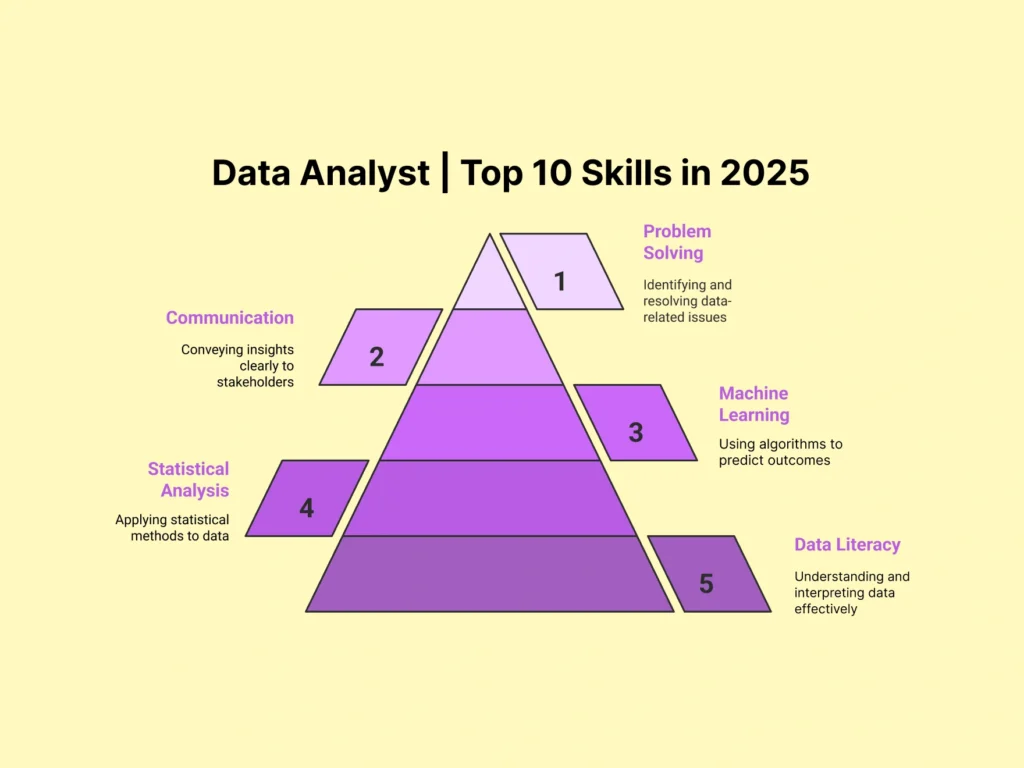Data is everywhere—streaming in from apps, sensors, websites, and more. Behind every chart, dashboard, and business decision, there’s a data analyst making sense of it all. As we head into 2025, the role of a data analyst is evolving faster than ever. New tools, larger data sets, and higher expectations mean that tomorrow’s analysts will need a broader, sharper skill set to stand out.
In this blog, Get to know the top skills you’ll need to thrive as a data analyst in 2025.
1. Statistical Analysis & Probability
At its core, data analysis is about making sense of numbers. You need to understand:
- Descriptive statistics (mean, median, mode) to summarize datasets quickly.
- Inferential statistics (confidence intervals, p-values, hypothesis testing) to draw conclusions about a larger population based on a sample.
- Probability distributions (normal, binomial, Poisson) to model real-world processes.
Think of statistics as your compass. It tells you not just what happened in the data, but how confident you can be in those insights.
2. SQL & Database Management
No matter how fancy new tools get, most data still lives in relational databases. SQL (Structured Query Language) lets you:
- Extract exactly the rows and columns you need.
- Join multiple tables to combine customer info with sales records.
- Aggregate data to calculate totals, averages, or counts by group.
In 2025, you’ll also see more demand for knowledge of NoSQL databases (like MongoDB) when working with semi-structured data (JSON, XML). But a strong SQL foundation remains non-negotiable.
3. Python (or R) Programming
Once you’ve pulled raw data with SQL, you’ll use a scripting language to clean, explore, and model it. Python is the current favorite, thanks to libraries like:
- pandas for data frames and manipulation
- NumPy for numerical operations
- scikit-learn for basic machine learning
- matplotlib or seaborn for quick plotting
R is also popular—especially in academia and some biotech firms—because of its built-in statistics tools and packages like tidy verse. Choose one (or both) and build real projects to prove your skills.
4. Data Cleaning & Preprocessing
They say 80% of analysis is cleaning. Messy data can include:
- Duplicates that skew counts.
- Missing values that break your code or bias results.
- Inconsistent formats (e.g., “Jan 1 2025” vs. “2025-01-01”).
Being meticulous about cleaning means you’re building on a solid foundation. Automating the process—using scripts that handle edge cases—will save you hours in the long run.
5. Data Visualization
Numbers are great, but pictures speak louder. You’ll need to turn your findings into clear, persuasive visuals:
- Static charts (bar plots, line charts, histograms) for reports.
- Dashboards (Tableau, Power BI, or Plotly Dash) to let stakeholders explore the data themselves.
- Storytelling—knowing which chart type to choose and how to annotate it so the key message jumps out.
Attention to color, labeling, and layout makes the difference between a chart people ignore and one they share in a meeting.
6. Basic Machine Learning
While not every data analyst builds complex AI systems, knowing the basics helps you:
- Build regression models to predict continuous outcomes (sales next quarter).
- Classify data into groups (spam vs. not spam).
- Cluster customers by behavior to uncover hidden segments.
You don’t need a PhD—just a working knowledge of algorithms, how to tune them, and how to evaluate their performance (accuracy, precision, recall).
7. Big Data Tools
When your datasets grow to billions of rows, single-machine tools choke. In 2025, you’ll want exposure to:
- Apache Spark for distributed computing, often through PySpark.
- Hadoop ecosystems (HDFS, MapReduce) on legacy projects.
- Cloud-native services like AWS Athena or Google BigQuery, which let you query massive data without managing servers.
Showing you can handle scale is a major plus on any resume.
8. Cloud Computing
More companies are moving their data and analytics pipelines to the cloud. Familiarize yourself with:
- AWS (S3 for storage, EC2 for compute, Redshift for data warehousing).
- Google Cloud (BigQuery, Cloud Storage, Compute Engine).
- Microsoft Azure (Data Lake, Synapse Analytics, Azure ML).
Knowing how to stand up resources, manage permissions, and optimize costs will make you a go-to analyst in any organization.
9. Business & Domain Knowledge
Pure technical skill isn’t enough. You also need to understand the context:
- Finance: What do KPI acronyms like ARR, EBITDA, or churn rate mean?
- Retail: How do supply chain lead times affect inventory analysis?
- Healthcare: Why are certain data privacy rules (HIPAA, GDPR) crucial when working with patient records?
When you speak the same language as your stakeholders, you can ask the right questions and deliver truly actionable insights.
10. Communication & Storytelling
Finally, your data analysis is only as good as your ability to explain it. You’ll need to:
- Write clear summaries that highlight the “so what” of your findings.
- Present results to non-technical audiences, using analogies or simple visuals.
- Recommend next steps—don’t just show the problem, propose a solution.
Being a strong communicator turns you from a “numbers person” into a trusted advisor.
The Way Forward
If you want hands-on training in these skills, consider the Data Science and Analytics program at FACE Prep Campus. We focus on:
- Real-world projects that mimic industry challenges
- Expert mentors from top companies
- 80% practical, 20% theory balance
- Internships and placement support
